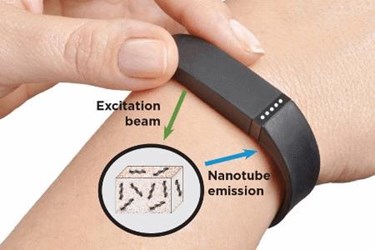Implantable Nanotubes Shine Infrared Light On Early Cancer Biomarkers

Researchers from the Memorial Sloan Kettering Cancer Center (MSK) have introduced cancer monitoring nanotechnology that they say is a “major step forward” compared to traditional biopsies. Nanotubes programed to safely absorb and emit infrared light — demonstrated in a proof-of-concept study with mice — could provide an “entire disease fingerprint” that leads to earlier diagnosis of cancer in both blood and tissue.
Research in the development of minimally invasive liquid biopsies is seeking to identify certain cancer biomarkers in the blood, and could provide diagnoses much sooner than traditional tissue biopsy, but even the most advanced biopsy cannot monitor a body continuously. Investigations with experimental implants have sought to create a cancer-monitoring system that could live inside the body and be periodically monitored, externally, for early signs of cancer growth. Scientists from the University of Michigan are developing an implant that can serve as an early warning system for breast cancer cells that have metastasized in lungs, liver, and brain.
MSK’s proposed cancer detection system could provide a non-invasive early diagnosis using both tissue and blood, and could be designed to signal the presence of many biomarkers at once, said David Heller, a molecular pharmacologist at MSK and leader of a study published in Nature Biomedical Engineering.
“We wanted to find a way to noninvasively measure biomarkers that are still in the body,” explained Heller in a press release. “Right now, it’s hard to tell if a patient has an aggressive cancer or if it’s safe to wait before another scan. If you could see a change in hours or days, it could give doctors an earlier warning.”
The nanotube biosensors — demonstrated in mouse models — work using infrared light that can easily and safely travel through several inches of tissue, or even bone. The tiny nanotubes can absorb infrared light from an external wearable and reflect light back to be analyzed for information of microRNAs and changes in their concentration. This monitoring can occur around the clock for real-time information about potential cancer growth.
According to study authors, the system is feasible in areas of the body that are challenging to biopsy, especially with minimally invasive efforts. The nanotubes could be implanted in tissue – or even in the brain - and visualized with an endoscope, because infrared light is powerful enough to travel through the skull.
Heller explained that this system will only get stronger and more useful as more disease biomarkers are identified and “disease fingerprints” are validated. Because the tubes can be programmed to detect many different types of microRNAs at the same time, the system could provide an early warning system based on an entire disease profile.
“A lot of these microRNAs we’re looking at seem to be potential indicators of disease, mostly cancers, that don’t currently have good early biomarkers,” Heller said. “The best ones need to be identified and validates so we know which ones to focus on as we take this technology forward.”
Earlier this year, a team from the University of Utah proposed a minimally invasive brain imaging system by attaching an infrared light source to glass surgical needles, technology they say could lead to a better understanding of neurological conditions.
